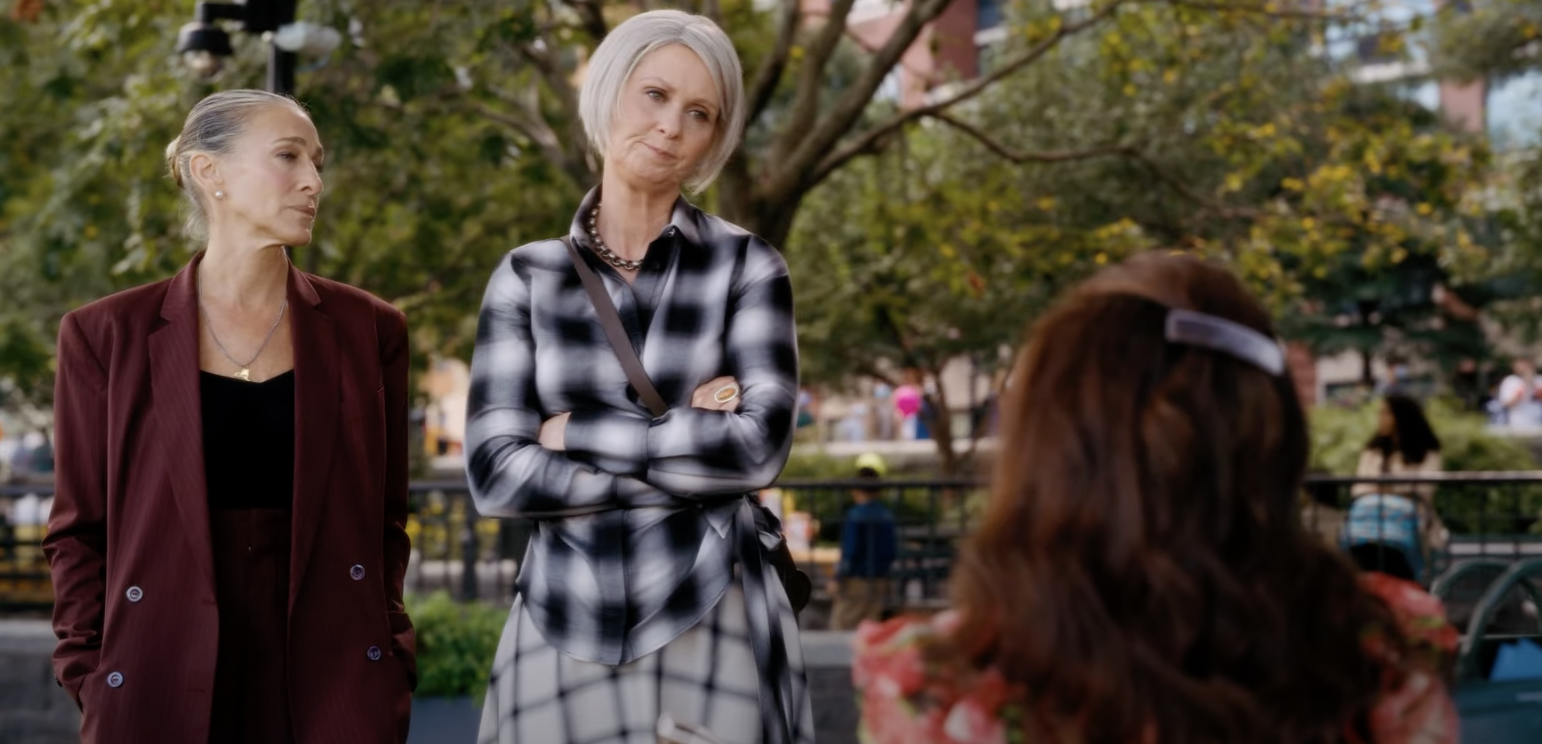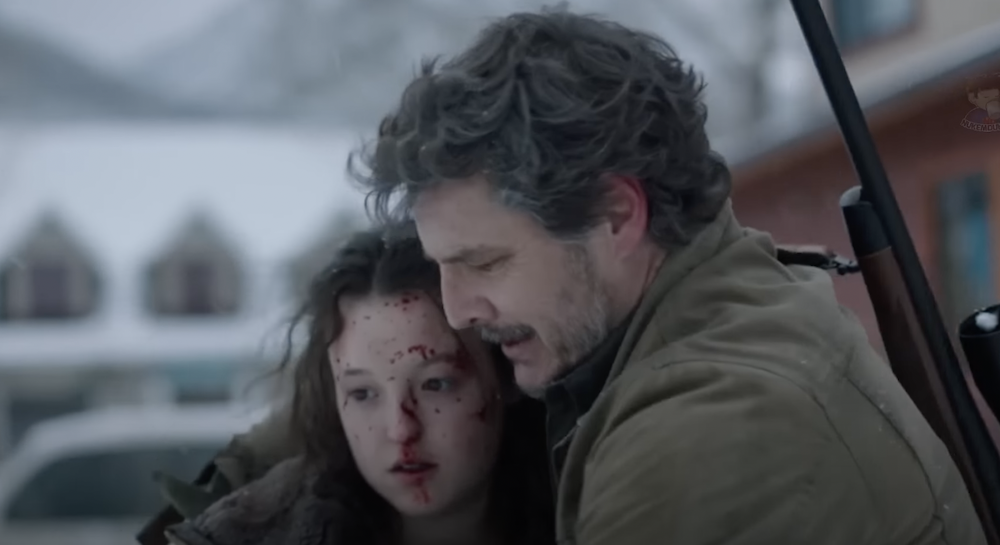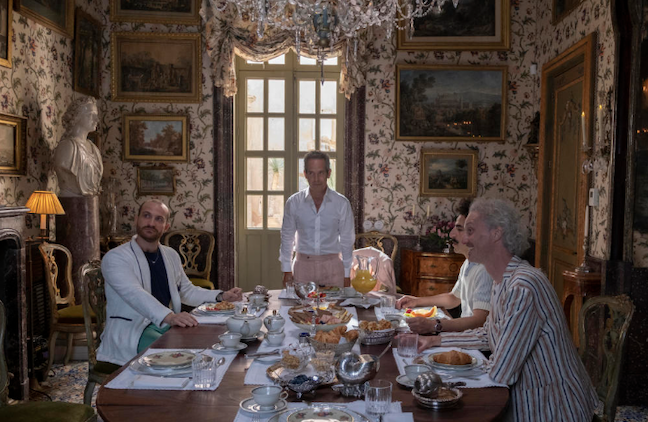Books & Culture
Everyone Has Moved On and I’m Still Thinking About Miranda’s Coming Out Scene
“And Just Like That” presents an honest portrayal of coming out later in life

If you’re queer and have watched And Just Like That you probably remember the picnic scene. In “Diwali,” episode 6 of the Sex and the City reboot, Miranda Hobbes, Charlotte York, and Carrie Bradshaw meet for lunch in a park along the East River. All is well until Miranda (Cynthia Nixon) reveals that she had sex outside of her heterosexual marriage and, that she did so with a non-binary person, the Che Diaz (Sara Ramirez). Glassy-eyed, Miranda asks Charlotte (Kristin Davis) not to have a big reaction. (Carrie already knows). She then very calmly says, “I had sex with Che at Carrie’s apartment after the surgery when we thought she was asleep.” Without missing a beat, Charlotte shrieks a bunch of rhetorical questions: head shaking, eyebrows raised, eyes bulging in a way that is reminiscent of her ex-mother-in-law Bunny, whom she once despised. She asks, “Are you GAY now?” Miranda immediately responds, “No,” but then shrugs: “I don’t know.” Charlotte continues: “You spent your whole life with men. You’re MARRIED to a MAN and now you’re suddenly having non-binary sex!… You are not progressive enough for this!”
In what feels more like hurt than anger, Miranda storms away from the table as Charlotte calls out, “You’re having a midlife crisis! You should have just dyed your hair!” Carrie (Sarah Jessica Parker) coaxes Miranda to return to resolve the disagreement. After watching this scene, I railed against Charlotte and the show to anyone who would listen—including my therapist. I began to recognize my queer identity about five years ago, in my late 20s, which until recently is not something I’ve often seen in life or media. Miranda’s vulnerability, confusion, overwhelm, and shame feel so true to the early days of me stepping into my queerness. And Just Like That took on a pivotal moment for older queer viewers and had Charlotte trample all over it. Her reaction ignited what, deep down, I still fear when coming out to anyone.
Her reaction to Miranda’s queerness in And Just Like That felt like a betrayal not only to Miranda, but to me.
I was always a Charlotte. At 12, I snuck TBS reruns of Sex and the City in my basement, thumb on the remote’s channel change button in case my parents walked in. I identified with how judgmental she could be, how much pressure she put on herself, and how conventional she was. She was possibly the only character who made sense to me when she admitted to thinking blowjobs are gross (lesbian clue #1). Binge watching the library box set DVDs during sleepovers with my ballet friends in high school, I looked around the room as Charlotte told her friends, “Maybe we can be each other’s soulmates. And then we can let men be these great, nice guys to have fun with” (lesbian clue #2). It was Charlotte who understood me (we even both attended Smith College—lesbian clue #3), which is why her reaction to Miranda’s queerness in And Just Like That felt like a betrayal not only to Miranda, but to me.
The coming out narratives we’re accustomed to seeing on TV often center on teenage characters, so I was especially tuned into this moment that felt closer to my own experience. It was painful to see Miranda vulnerable in a way I was intimately familiar with and to witness what felt like rejection from Charlotte. (Carrie’s lack of eye contact throughout the conversation wasn’t so hot either.) But after months of rumination, I’ve come to realize that sometimes the truest depictions of coming out moments on TV are also the most uncomfortable. And perhaps just because they feel uncomfortable doesn’t mean they’re necessarily bad representation—or bad TV.
With a few months of distance, I’m able to think about Charlotte’s reaction less emotionally and more critically. By the end of the picnic conversation, she tells Miranda she wants to understand and asks, “What is wrong with people just staying who they were?”—also a reference to Charlotte’s child Rock (Alexa Swinton), who is exploring their gender expression. Carrie, in a rare moment of wisdom (the only writer character I will ever respect is Jo March and that’s final), chimes in with “Some of us just don’t have that luxury.” Charlotte doesn’t yet understand that there’s an inevitability to being queer. It’s a whole different way of looking at the world and it’s really not possible to stay who you were once you open that door.
Charlotte doesn’t yet understand, but she will. If anything is true about both the Charlotte of the original series and the reboot, it’s that she is committed to and capable of growth (another reason I identified with her). We’re talking about the woman who abandoned deeply ingrained dreams of a WASPy future to convert to Judaism for Harry Goldenblatt (Evan Handler). By the end of the first season of And Just Like That, she is more open to understanding Miranda and Rock, even throwing Rock an obscenely expensive “they-mitzvah.”
I’ve had people of her generation push back, question my identity, and ask me to defend or prove my choices.
While it was painful for me to watch Charlotte react to Miranda the way she did, I recognize that it’s not possible for any televised coming out moment to appease every viewer. Coming out is different for everyone, and it’s not one thing, done one time, in one way. It’s an ongoing, lifelong process. There’s also a generational element to Charlotte’s response. Maybe the picnic scene bothered me so much not just because it felt homophobic, but because it did feel realistic to how women of Charlotte’s generation sometimes react. I’ve had people of her generation push back, question my identity, and ask me to defend or prove my choices, albeit less aggressively. It’s the fluidity that seems difficult to understand. How could someone who has, until this moment, seemed straight come to a different conclusion about themselves? If this is truly their identity, why didn’t they figure it out sooner? Without exposure to stories like mine and Miranda’s, some people don’t trust the legitimacy of a later in life identity shift. In this way, Charlotte’s response is both true to her character and true to life. Can we, as viewers, fault a TV show for putting a version of truth on screen when it’s a truth we don’t want to see?
In the last couple of years, we’ve seen more positive reactions to characters coming out on TV, non-reactions, and queer stories that don’t address coming out. There’s Dr. Kai Bartley (E.R. Fightmaster) on Grey’s Anatomy, whose storyline focuses not on the fact that they’re non-binary, but on their Alzheimer’s research and budding relationship with Dr. Amelia Shepherd (Caterina Scorsone). Taissa Turner (Tawny Cypress) on Yellowjackets deals with the aftermath of surviving a plane crash while running for political office with little mention of her sexuality. And Just Like That is not one of those shows. When Miranda’s storyline and Charlotte’s response didn’t fall into a familiar category, it was a bit of a shock to my system.
The purpose of And Just Like That seems to be to rectify the lack of inclusivity in Sex and the City, and that’s certainly true of Miranda’s queer storyline and coming out. The original show’s characters were mostly straight, cis, and white. The few LGBTQ+ characters and characters of color were stereotypes. Carrie’s gay best friend Stanford Blatch (Willie Garson) and Charlotte’s gay best friend Anthony Marentino (Mario Cantone) were caricatures, interested mainly in fashion, sex, and making fun of people. The reboot brings more diverse characters, but not in a way that’s progressive. The characters of color function largely as bolsters for the main characters without much depth of their own. Do we know anything about Lisa Todd Wexley (Nicole Ari Parker), other than she’s a documentarian, the “Black Charlotte” who Charlotte wants to impress, plays tennis, collects art, and sometimes has marital discord but not in a way that moves the plot forward? Does representation mean anything if it’s done superficially? Writer Melanie Curry explains, “When viewers of color ask for inclusivity, we want genuine and honest representation—not side characters who are the punchline of every joke.”
The characters of color function largely as bolsters for the main characters without much depth of their own.
Curry’s insight is true for the LGBTQ+ characters in the reboot, too. As with the new characters of color, And Just Like That’s newest queer character, Che, is a caricature of someone who is non-binary, bisexual, and a comedian. They wield a “woke moment” button during their podcast, are self-obsessed and sex-obsessed, and have a very soapbox-y standup routine. After having sex with Miranda, Che suggests Miranda DM them on Instagram if she wants to hang out again, which, in my experience, is not how real people make plans. Then there’s trans character Rabbi Jen (Hari Nef), who pops up in the season finale to help Rock study for their they-mitzvah and affirm the strength of Carrie and Miranda’s friendship from a public restroom stall. We don’t know anything about Rabbi Jen (though there is a they-mitzvah program prop with her bio!) but Twitter users immediately called for a spin-off.
While perhaps there are elements of Stanford, Anthony, Che, and Rabbi Jen that viewers connect with, it’s Miranda who has all the depth. And Just Like That allows her to explore how unsettling, overwhelming, and confusing it can be to embrace your own queerness, which is invaluable for both queer and straight viewers. When Che tells Miranda it’s a turn-on to ask for what she wants, Miranda replies, “I didn’t know that!” In this moment, adults stumbling within their queerness everywhere felt seen. When Miranda surprises Che at their apartment with cookies and Che isn’t instantly responsive, Miranda flies down the stairs, calls herself “so fucking stupid,” and questions why she came over. Writer Heather Hogan has identified what we are seeing Miranda work through as “late-blooming queer mania,” and that feels accurate.
Having your sexual or gender identity shift at any age, but especially as a fully-formed adult, can be daunting and disorienting.
Within the queer community, we discuss how the most genuine queer narratives in film and television don’t revolve around coming out at all. Instead, they examine queer people living their everyday lives while navigating their evolving identities. Generally I agree with this. But coming out in adulthood is a different animal. Having your sexual or gender identity shift at any age, but especially as a fully-formed adult, can be daunting and disorienting. Seeing how Gen Z so fearlessly embraces their identities both on TV and in real life, it’s easy for Gen X and Millennials who didn’t or couldn’t come out earlier to feel left behind. All of this is why Miranda’s story matters. That representation needs to be on TV precisely because it rarely has been. Watching Miranda navigate her identity—and messily—is validating and valuable for those of us coming out later in life. Even if it’s painful or uncomfortable, we need to see her vulnerability as she stumbles through the process of getting to know herself. What we don’t need to see is queer and minority characters without nuance, or worse stereotypes and caricatures.
And Just Like That is HBO Max’s most-streamed series of all time, and it spurred wide internet discourse on race, gender, disability, age, and sexuality. It wasn’t always productive, but published essays and social media posts did move the conversation forward. I didn’t think critically about the way Miranda’s husband Steve Brady’s (David Eigenberg) hearing disability was being portrayed until a hearing impaired friend posted about it on Facebook. I was beginning to side with the Che haters when a writer tweeted that not allowing Che the same grace we gave our Sex and the City main characters as they made questionable romantic choices for two decades is not okay. And I’ve seen more conversations about coming out later as a result of Miranda’s storyline. I’m begrudgingly grateful for the discourse that And Just Like That has brought to the surface. It feels a little like therapy for 12-year-old me—the me who might have realized her identity earlier, if she had the kind of TV shows and media discourse we have now—including, I suppose, the picnic scene.








